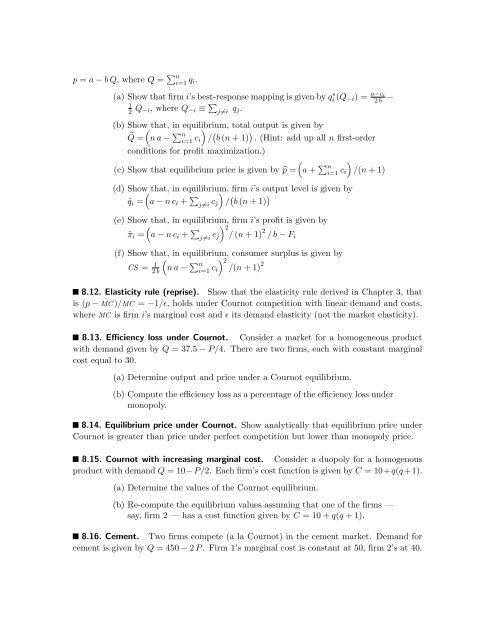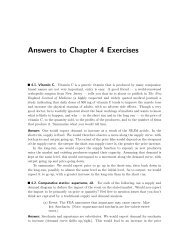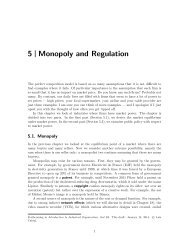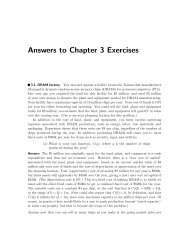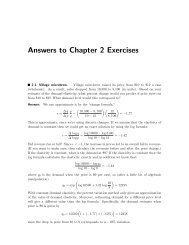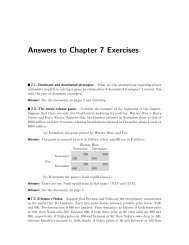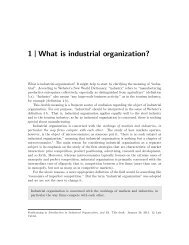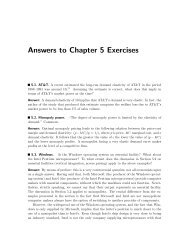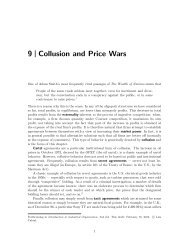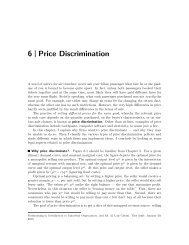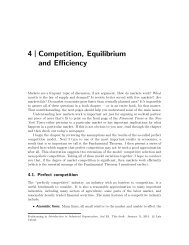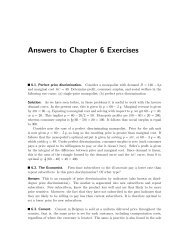8 Oligopoly - Luiscabral.net
8 Oligopoly - Luiscabral.net
8 Oligopoly - Luiscabral.net
You also want an ePaper? Increase the reach of your titles
YUMPU automatically turns print PDFs into web optimized ePapers that Google loves.
p = a − b Q, where Q = ∑ n<br />
i=1 q i.<br />
(a) Show that firm i’s best-response mapping is given by qi ∗(Q −i) = a−c i<br />
1<br />
2 Q −i, where Q −i ≡ ∑ j≠i q j.<br />
2 b −<br />
(b) Show(<br />
that, in equilibrium, total output is given by<br />
̂Q = n a − ∑ )<br />
n<br />
i=1 c i / ( b (n + 1) ) . (Hint: add up all n first-order<br />
conditions for profit maximization.)<br />
(<br />
(c) Show that equilibrium price is given by ̂p = a + ∑ )<br />
n<br />
i=1 c i /(n + 1)<br />
(d) Show(<br />
that, in equilibrium, firm i’s output level is given by<br />
ˆq i = a − n c i + ∑ )<br />
j≠i c j / ( b (n + 1) )<br />
(e) Show that, in equilibrium, firm i’s profit is given by<br />
(<br />
ˆπ i = a − n c i + ∑ 2/<br />
j≠i j) c (n + 1) 2 / b − F i<br />
(f) Show that, in equilibrium, consumer surplus is given by<br />
(<br />
CS = 1<br />
2 b<br />
n a − ∑ ) 2<br />
n<br />
i=1 c i /(n + 1)<br />
2<br />
8.12. Elasticity rule (reprise). Show that the elasticity rule derived in Chapter 3, that<br />
is (p − MC )/MC = −1/ɛ, holds under Cournot competition with linear demand and costs,<br />
where MC is firm i’s marginal cost and ɛ its demand elasticity (not the market elasticity).<br />
8.13. Efficiency loss under Cournot. Consider a market for a homogeneous product<br />
with demand given by Q = 37.5 − P/4. There are two firms, each with constant marginal<br />
cost equal to 30.<br />
(a) Determine output and price under a Cournot equilibrium.<br />
(b) Compute the efficiency loss as a percentage of the efficiency loss under<br />
monopoly.<br />
8.14. Equilibrium price under Cournot. Show analytically that equilibrium price under<br />
Cournot is greater than price under perfect competition but lower than monopoly price.<br />
8.15. Cournot with increasing marginal cost. Consider a duopoly for a homogenous<br />
product with demand Q = 10−P/2. Each firm’s cost function is given by C = 10+q(q +1).<br />
(a) Determine the values of the Cournot equilibrium.<br />
(b) Re-compute the equilibrium values assuming that one of the firms —<br />
say, firm 2 — has a cost function given by C = 10 + q(q + 1).<br />
8.16. Cement. Two firms compete (a la Cournot) in the cement market. Demand for<br />
cement is given by Q = 450 − 2 P . Firm 1’s marginal cost is constant at 50, firm 2’s at 40.


